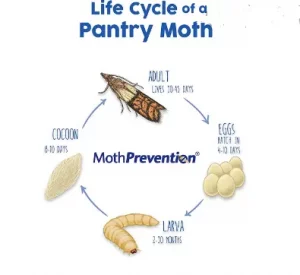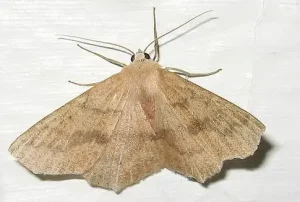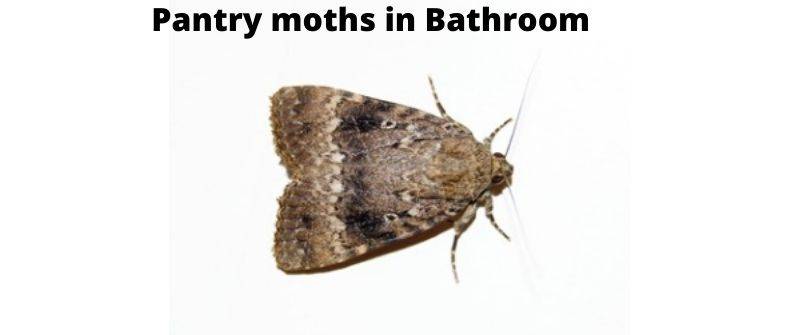Pantry moths are meal moths commonly found in the United States. They are also referred to as Indian meal moths. They are insects that are small winged, brown-grey and tan hues.
These insects are not harmful to people and pets. As small as they look, they can lay up to 400 eggs at a time which hatch in a week.
Therefore, if you notice pantry moths in your bathroom you might need to get rid of them or you might be dealing with an eclipse of moths in no time.
Pantry moths go through four stages in their lifetime:
1. Egg
They are small and whitish grey in color. They hatch in seven days after they are laid. This is usually in places with abundant food.

2. Larva
It is the damage stage. They are tiny worms eating machines.
They contaminate the food they eat and their color depends on the food too.
The larva can last for 2-3 months depending on conditions it is under.
3. Pupa
In this stage they are in cocoons in hidden places such as corners.
Cocoons are buried underneath foods and are mostly noticed when there is already an infestation.
Pupas take 15-20 days to develop into adults
4. Adult
They appear as winged insects attracted to light and fly all around with the purpose of finding mates for reproduction.
What causes pantry moths in bathroom?
1. Flying through the open bathroom windows
Pantry moths are likely to find way into your bathroom through the bathroom ventilation windows which mostly stays open.
These moths however will stay if they find food. Therefore, they are likely to make way to your kitchen or living room where dry foods can be easily found.
2. Bathtub snacks
Pantry moths love dry foods. Therefore, people who love having their snacks while in the bathtub risk inviting pantry moths in their bathrooms.
These moths can be inside the snacks packaging because they can easily get in paper wrappers and paper boxes or have cocoons on the jars and cans.

If you mistakenly leave your snacks on the bathtub for long, you provide a breeding ground and food for pantry moths.
3. Major infestation
The fact that a female moth can lay 400 months at a time which hatch and grow into moths, there must many moths in your home if all the eggs are hatched.
Therefore, they can easily end up in your bathroom.
4. Eggs laid in the bathroom
If pantry moths pass through your bathroom shelves, they can lay eggs. These eggs can then later be hatched and grow into moths.
The corners of the shelves can be good environment for the larvae to grow and turn into moths.
Why having months in the bathroom is odd
It is odd having pantry moths in the bathroom because they are likely found on dry foods, bulk cereals and grains. Also, spilled food and unseal food containers are the main attracts for female moths that lay eggs.
These should be found in your kitchen and not your bathroom. Also, they like warmer temperatures and most bathrooms are mostly wet and cold therefore making it odd having pantry moths in your bathroom.
Being insects that thrive in places with abundant food supply, bathrooms are not the ideal places for moths to thriving.
Can pantry moths invade bedroom?
If you have noticed pantry moths in your bathroom and you are wondering how that happened, then there are several explanations for that.
1. Open windows.
Pantry moths may have come into your bedroom through the windows. Bedroom windows are mostly opened for ventilation and fresh air and that opens way for many insect including pantry moths to access the room Pantry moths’ invasion

If your bedroom is closer to your kitchen which has pantry moths, then they can make way into the room. This is common especially in search for light and corners to build webs and cocoons
2. Food stuffs in the bedroom
Carrying dry snacks into your bedroom is the most common way that can cause pantry moths. Pantry moths like dry foods.
Sometimes they come in these foods or find their way into them because they can eat through most of the food covers such as paper rappers and boxes.
A tiring day where you just want to lay on the bed with your snacks watching something on your phone or laptop might be the day that you invite pantry moths into your bedroom.
How to remove moths from your bathroom/bedroom?
- The best way to get rid of pantry moths is to make sure that they have no access to food. Therefore, dry foods should be stored in sealed containers that are airtight with fitting tight lids. To get rid of any eggs that might be laid by the moths in dry foods, place them in the fridge for three to four days.
- In case of an infection inspect all areas of your house to make sure that you will eradicate all moths. You can look particularly where the walls and the ceiling meet at a right angle. Also, you can look around door frames and window trims. These all are proper spots for larvae to build cocoons. Once you find them, clean them away, spray and wipe the area with a 50-50 mix of water and vinegar to remove any eggs.
- Also, avoiding carrying foods in bathrooms and bedrooms can help avoid any invasion of pantry moths in those rooms. Without these dry foods that pantry moths live on then they cannot exist. All eating should be done on the dining table and snacks stored in the kitchen in tight sealed containers. Additionally, making sure that there are no pantry moths in your kitchen reduces the chances of having pantry moths in your bedroom and bathroom.
- Another method is making sure that you use transparent curtains on your windows especially during the summer when there is increased number of pantry moths. Transparent curtain will lighten up your bedroom and prevent pantry moths from getting in your bathroom.
- When dealing with pantry moths never be in a hurry of eradicating them. Always make sure that you are confident that you have eliminated them before you stop the different ways used to eradicate them.

As a homeowner, I am specifically keen on home improvement. I am passionate about homes, yards, and home improvement. I blog on home ideas and reviews on solutions that make homes better.

